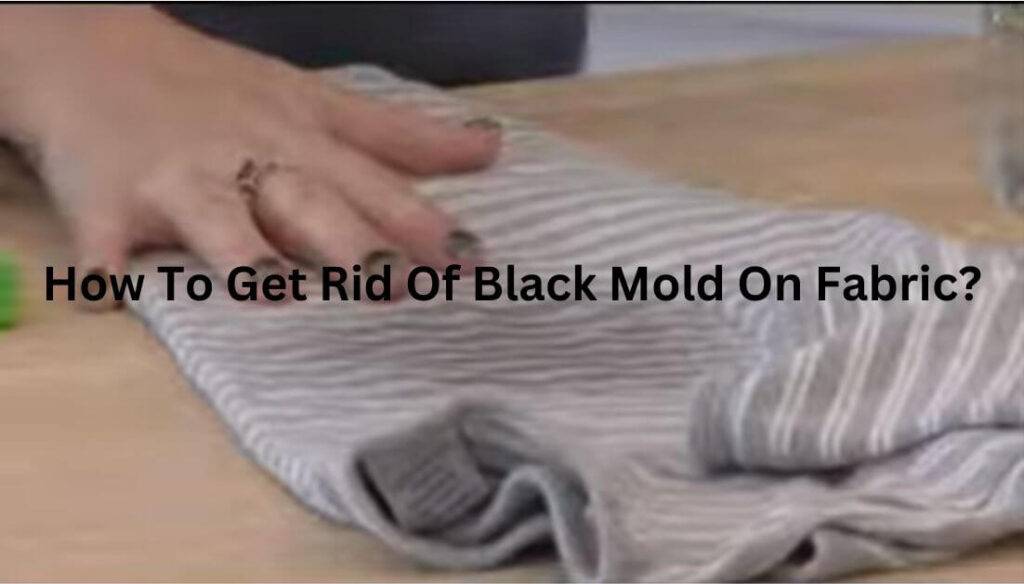Last Updated on October 20, 2024 by Wahid
Ever unearthed a favorite shirt from the back of the closet, only to discover a fuzzy surprise – mold? Mold thrives in damp environments and lack of ventilation, creating a common laundry woe. While discarding moldy clothes might seem like the easiest solution, you can often revive them with proper washing techniques. But can you put moldy clothes in the washing machine? Thus, this guide will answer that question in detail, explore best practices for washing moldy clothes, address common concerns, & even offer alternative solutions if the mold proves too stubborn.
Can You Really Wash Moldy Clothes?

Mold on clothes can be a real downer. You might reach for a favorite shirt only to discover fuzzy patches and a musty odor. While tossing the garment might seem like the quickest solution, washing moldy clothes can be an option. However, it’s crucial to approach it with caution to avoid spreading mold spores and potentially harming your health.
Here will answer the question: Can you wash moldy clothes? We’ll also explore:
- Pre-treatment methods to address visible mold before washing.
- Safe washing practices to eliminate spores effectively.
- Warnings and precautions to protect yourself and your washing machine.
- Alternative solutions for heavily mold-infested garments.
However, by following these steps, you can potentially salvage your favorite clothes and keep your laundry routine mold-free.
Can You Put Moldy Clothes in the Washing Machine: Clean Moldy Clothes Safely
Mold on clothes can be a frustrating discovery, but fear not! With the right approach, you can often revive moldy garments in your washing machine. Here’s how to wash moldy clothes safely and effectively:
Hot Water is Your Ally:
- Temperature Matters: Select the hottest water temperature your clothes can tolerate according to the care label. Hot water (above 140°F/60°C) is crucial. Mold spores are resilient, and hot water helps ensure their demise. Cold or warm water just won’t cut it.
Isolating Moldy Clothes:
- Protect Your Clean Laundry: Wash moldy clothes alone, & separate them from other garments. Mold spores are easily transferred, so keeping them isolated prevents them from spreading to clean clothes in the wash.
Extra Rinse for Peace of Mind:
- Double Down on Cleanliness: Add an extra rinse cycle to your wash program. This ensures thorough removal of not only mold spores but also any cleaning solution residue that might linger on the fabric.
- Banish Dampness: Mold thrives in damp environments. Completely dry moldy clothes after washing. Direct sunlight is a natural mold killer, or use the hottest dryer setting suitable for the fabric.
Generally, by following the steps to put moldy clothes in the washing machine, you can effectively eliminate mold spores & potentially save your favorite clothes. However, remember, safety comes first!
Warnings & Safeguarding Your Health: Essential Precautions
While washing moldy clothes can be an effective solution, there are crucial safety measures to consider:
Severe Mold Infestation:
- Know When to Say Goodbye: For clothes with extensive mold growth, a strong musty odor, or damaged fabric, consider discarding them responsibly. Double-bag them in sealed plastic bags before throwing them away. Extensive mold growth poses health risks and can easily spread in your home. When in doubt, err on the side of caution.
Protecting Yourself:
- Breathe Easy for Those with Sensitivities: If you have allergies or respiratory sensitivities, wear a mask and gloves while handling moldy clothes. Avoid inhaling mold spores, which can irritate respiratory systems.
Washing Machine Maintenance:
- Don’t Let Mold Take Over Your Machine: After washing moldy clothes, consider running a cleaning cycle with hot water and bleach (if suitable for your machine according to the manual). This helps disinfect the washing machine drum & prevent future mold growth within your machine itself.
Additional Considerations:
- Fabric Care Labels: Always follow the fabric care instructions on the garment label. Some fabrics might not tolerate hot water washing or bleach use. Check before proceeding.
- Professional Cleaning: For heavily soiled or delicate garments with mold, consider professional cleaning services. They have the expertise and equipment to handle more challenging cases.
Ultimately, by following these precautions, you can safely wash moldy clothes and protect yourself & your washing machine from potential harm. Remember, prevention is key. Store clean clothes in a dry, well-ventilated area to prevent future mold growth.
Washing Machine Mold Removal: Effectiveness Explained
While a hot water wash can be a weapon against mold on clothes, it’s not a guaranteed one-shot solution. Here’s a breakdown of the factors affecting how well your washing machine tackles mold spores:
The Power of Hot Water:
- Heat is Key: As you mentioned, hot water (above 140°F/60°C) is crucial. Hot water disrupts the cell walls of mold spores, effectively killing them. Lower temperatures won’t be as effective.
Mold Severity Matters:
- Early Intervention is Best: The effectiveness of washing also depends on the severity of the mold infestation. For light to moderate mold growth, a hot water wash with proper pre-treatment (covered earlier) can be very effective. However, extensive mold growth might require additional cleaning steps, like stronger cleaning solutions or professional cleaning.
Fabric Type: Not All Fabrics Are Created Equal:
- Care Label is Your Guide: Some fabrics, such as delicates or those with specific care instructions, might not tolerate hot water washing. Always check the care label on your clothes before proceeding. For these fabrics, consult a professional cleaning service or consider alternative solutions like spot cleaning with a mold-killing solution suitable for the fabric.
Beyond Washing: A Holistic Approach
Remember, washing is just one step in the mold removal process. Here’s how to ensure complete success:
- Pre-treat the mold as described earlier.
- Dry thoroughly in direct sunlight or a hot dryer.
- Consider an extra rinse cycle for added peace of mind.
Moreover, by understanding these factors and following a comprehensive approach, you can significantly increase the chances of successfully removing mold from your clothes using your washing machine.
Should You Throw Out Moldy Clothes?

While washing can often save moldy clothes, there are times when discarding them is the wiser choice. Here’s when to say goodbye to moldy garments:
Severe Mold Infestation:
- Extensive Growth Means Farewell: If the mold covers a large area of the clothes, it’s best to discard them. Extensive mold growth indicates a significant presence of spores, making it difficult to eliminate them completely through washing.
Fabric Damage:
- Beyond Repair, Beyond Rescue: If the mold has caused visible damage to the fabric, such as weakening or discoloration, it’s time to let go. Washing such clothes might further damage them and compromise their safety for wear.
The Unrelenting Musty Odor:
- Smell is a Telltale Sign: Even after washing, if a strong musty odor persists, it indicates that mold spores might still be present. Discarding the clothes is the safest option to prevent further exposure and potential health risks.
Discarding Responsibly:
- Double Bagging for Safety: When discarding moldy clothes, double-bag them in sealed plastic bags. This prevents mold spores from spreading throughout your home or into the environment. Dispose of the bags according to your local waste disposal guidelines.
Considering Alternatives:
While discarding might seem like a loss, remember there are ways to refresh your wardrobe. Consider shopping for second-hand clothes or exploring sustainable clothing options.
Remember, prioritizing your health and preventing the spread of mold is the ultimate goal. By following these guidelines, you can make informed decisions about when to wash or discard moldy clothes and keep your laundry routine mold-free.
Are Moldy Clothes Ruined? Revive or Retire
Discovering mold on your clothes can be disheartening, but don’t despair. The answer to “Are moldy clothes ruined?” depends on the severity of the situation.
Salvaging Your Garments:
- Early Action is Key: The quicker you address mold growth, the better the chances of saving your clothes. Prompt action prevents mold spores from deeply embedding in the fabric.
- Proper Cleaning Techniques: Following the steps outlined in this guide, including pre-treatment, hot water washing, & thorough drying, can effectively eliminate mold spores on lightly to moderately moldy clothes.
When Clothes Need Letting Go:
- Extensive Mold Infestation: If the mold covers a large area, discarding the clothes is the safest option. Extensive mold growth signifies a large number of spores, making complete removal through washing difficult.
- Fabric Damage: If mold has caused visible damage like weakening or discoloration, it’s best to say goodbye. Washing such clothes might further damage them and compromise their wearability.
- Lingering Musty Odor: Even after washing, a strong musty odor indicates the presence of remaining mold spores. Discarding the clothes prevents further exposure and potential health risks.
Looking Beyond Discarding:
While discarding moldy clothes might seem like a loss, there are ways to refresh your wardrobe! Consider these alternatives:
- Thrifting & Second-Hand Stores: Explore pre-loved clothing options for a sustainable & budget-friendly way to replace your lost garments.
- Sustainable Clothing Brands: Research brands committed to eco-friendly practices and ethical production.
Yes, by following these guidelines, you can determine if your moldy clothes can be saved or need to be discarded. Remember, prevention is key. Store clean clothes in a dry, well-ventilated area to prevent future mold growth.
What Happens if You Wash Clothes with Mold on Clothes?
Washing moldy clothes can be a gamble. While it might eliminate mold on the affected garment, a crucial mistake can spread the problem. Here’s what you should avoid:
The Spore Shower:
Imagine this: you toss moldy clothes into the washing machine with your favorite clean shirt. During the wash cycle, especially with cold or warm water, mold spores can detach from the moldy clothes. These spores can then float around in the washer drum & potentially land on your clean clothes. The result? Mold growth not just on the originally moldy garment, but also on your previously clean clothes!
Preventing the Spread:
To avoid this unpleasant scenario, always follow the guidelines outlined earlier:
- Wash Moldy Clothes Alone: Never wash moldy clothes with other garments in the same load. Treat them in a separate wash cycle to prevent spore transfer.
- Hot Water is Your Friend: Remember, hot water (above 140°F/60°C) is crucial for killing mold spores. Cold or warm water won’t be effective and might even aid in spore dispersal.
By following these simple steps, you can effectively wash moldy clothes without putting your other garments at risk.
Remember: Safety and Hygiene Come First!
- Pre-treat the mold before washing to further loosen spores and prevent them from spreading during the wash cycle.
- Consider an extra rinse cycle to ensure complete removal of mold spores and cleaning solution residue.
- Clean your washing machine after washing moldy clothes (if suitable for your machine) to prevent future mold growth within the drum.
Now, by prioritizing these practices, you can keep your laundry routine safe and mold-free.
Conclusion
Mold on clothes can be a downer, but fear not! This guide has empowered you to answer the question “Can you put moldy clothes in the washing machine?” with confidence. By following the steps outlined here, you can effectively eliminate mold spores & potentially breathe new life into your favorite garments.
Remember, prevention is key. Hence, store clean clothes in a dry, well-ventilated area to create a mold-unfriendly environment. Don’t let mold win! With the knowledge you’ve gained, you can tackle moldy clothes with confidence, keeping your laundry routine & wardrobe fresh and mold-free.


